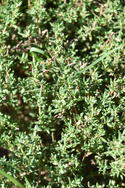Yield - tonnes per hectare per year

Conservative
Fresh: 4 tonnes
Dry: 1 tonne
Oil: 30 litres
Average
Fresh: 10 tonnes
Dry: 2 tonnes
Oil: 60 litres
Good
Fresh: 20+ tonnes
Dry: 4+ tonnes
Oil: 150+ litres
Harvesting
Harvesting of thyme is done both manually and mechanically depending on the size of the operation. On smaller production units and in greenhouses, it is done by hand. Fresh production: start harvesting early in the morning when the temperature is still cool. Harvesting of the fresh tips can start as early as 12 weeks after planting the thyme seedlings.
Dry production: For dried thyme production, cutting can be started as soon as there are enough leaves to be harvested. Most of the vegetative growth is cut away just before full flowering commences, when the potency of the oils are at their highest.
The cuttings are then dried at 32°C. Do not use air warmer than 36°C as it will cause the volatile oils to leave the herb and the flavour and scent will be lost.
Essential oil production: The best essential oils come from harvesting and distilling the thyme leaves just before they go into full flower when the oils in the plant are at their most pungent. Full production can be expected from the second year.
Storage
Fresh production: After harvesting, store fresh thyme at 4°C. The thyme can be stored for about two weeks. The relative humidity in storage should be kept above 95% to prevent dehydration. Fresh herbs lose their culinary flavour fast so it is best to market and use fresh cut thyme as quickly as possible.
Dry production: The dried leaves are packaged in airtight containers as soon as possible so they retain their colour and flavour. Keep at about 10°C. The dried thyme can also be frozen in sealed packaging. Essential oil: Store bottled essential oils in a dry dark and cool space for about a year to 18 months after bottling. After this, the oils start to lose their potency and scent.
Aromatic herbs like thyme generally have fewer pests and diseases as the strong pungent scent of thyme acts as an insect repellent. It is, however, best to follow a crop protection regime prescribed by an extension officer or agronomist.
The local chemical salesmen generally have the right programmes or could provide information as to the best advisors available in close proximity to the production area.